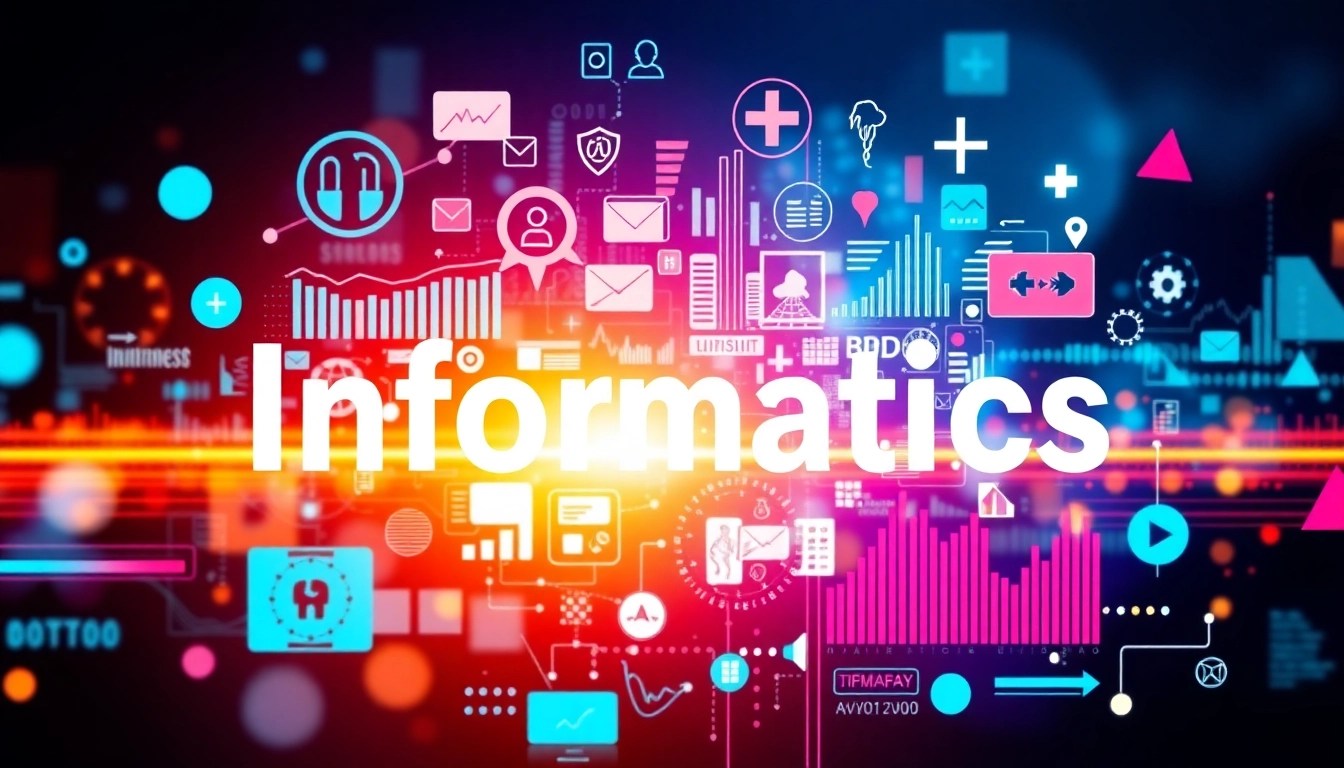Understanding Informatics and Its Impact
Informatics is a rapidly evolving field that intersects data, technology, and human behavior, fundamentally transforming how organizations operate across various sectors, particularly healthcare. The integration of informatics into healthcare systems has not only enhanced patient care but also streamlined operations and improved healthcare delivery efficiency. As we delve into the world of informatics, we can explore its definitions, roles, and the immense benefits it can bring to modern practices. For a deeper understanding of health informatics and its impact, you may refer to https://www.informaticsview.com.
What is Informatics?
Informatics is defined as the study, design, and application of information technology to manipulate and manage data for better decision-making, problem solving, and organizational efficiency. In essence, it’s about crafting systems that effectively collect, analyze, and utilize information to produce valuable insights.
The field encompasses various disciplines including health informatics, bioinformatics, social informatics, and more, each targeting specific domains. The core principle remains the same: to leverage information technology for enhanced outcomes.
The Role of Informatics in Healthcare
Within healthcare, informatics plays a pivotal role in revolutionizing patient care and healthcare delivery. Informaticians work closely with healthcare providers to design systems that enhance patient safety, improve quality of care, and increase efficiency. This is achieved through the implementation of Electronic Health Records (EHRs), clinical decision support systems (CDSS), and telehealth solutions.
For example, EHRs allow for the seamless sharing of patient data, which reduces redundancy and ensures that clinicians have access to accurate information when making treatment decisions. Furthermore, predictive analytics and data mining techniques help informatics professionals identify trends, allowing for proactive rather than reactive patient care.
Key Benefits of Informatics in Modern Practices
- Improved Patient Outcomes: Data-driven insights lead to more personalized treatment plans and better health outcomes.
- Increased Efficiency: Process automation reduces the time staff spend on administrative tasks, allowing more focus on patient care.
- Enhanced Communication: Interoperable systems improve collaboration between departments and care providers, ensuring coordinated care.
- Cost Savings: Effective informatics can reduce unnecessary tests and interventions, significantly cutting costs.
Technological Innovations in Informatics
Current Technologies Shaping the Field
The landscape of informatics is largely defined by continuous technological innovation. Current technologies shaping this field include cloud computing, artificial intelligence (AI), big data analytics, and blockchain. These technologies provide powerful tools for data storage, security, and analysis.
AI, for instance, aids in identifying patterns and providing predictive analytics in patient care, while big data allows healthcare organizations to analyze vast amounts of information for actionable insights. Cloud computing, on the other hand, ensures that data is accessible and secure, facilitating collaborative approaches to healthcare delivery.
Case Studies of Successful Implementations
Several healthcare organizations have successfully implemented informatics solutions that showcase its potential. For example, the Mayo Clinic employs a robust electronic health record system that integrates clinical data, lab results, and imaging studies. This system significantly enhances patient safety and care delivery, showcasing how informatics can transform operational capabilities.
Another notable case is that of Mount Sinai Health System, which utilizes AI-driven algorithms to predict patient deterioration and guide timely interventions. The results have been promising, with reduced hospital readmissions and improved patient outcomes.
Future Trends in Healthcare Informatics
Looking ahead, several trends are expected to shape the future of healthcare informatics. The rise of personalized medicine, driven by advanced data analytics and genomics, will redefine treatment approaches.
Furthermore, the integration of wearable technology is likely to become mainstream, providing real-time data that informs healthcare decisions on the go. Additionally, with the growing importance of data security and patient privacy, there will be increased focus on cybersecurity measures within informatics systems to protect sensitive information.
Data Management and Analysis
Effective Data Governance Practices
Effective data governance is crucial in ensuring that healthcare data is accurate, accessible, and secure. Establishing robust governance frameworks includes defining data ownership, implementing policies for data quality, and ensuring compliance with regulations such as HIPAA.
Organizations must prioritize transparency and accountability in their data practices, cultivating a culture where all stakeholders understand the significance of accurate data and its implications on patient care.
Data Analytics Tools and Techniques
Data analytics tools play an essential role in transforming raw data into actionable insights. Tools such as Tableau, SPSS, and Microsoft Power BI enable healthcare professionals to visualize data effectively, leading to informed decisions.
Moreover, employing techniques such as descriptive, diagnostic, and predictive analytics allows organizations to understand past trends, analyze current practices, and anticipate future needs. By integrating these analytical strategies, healthcare leaders can make data-driven decisions that enhance the quality of care.
Challenges in Data Management
While the potential benefits of informatics are significant, challenges in data management exist. One primary challenge is ensuring data interoperability between diverse healthcare systems. Many organizations rely on legacy systems that do not communicate effectively, creating silos of information.
Another challenge is maintaining data security, as increased connectivity opens up vulnerabilities that could lead to data breaches. To mitigate these risks, organizations must invest in comprehensive cybersecurity strategies and regularly update their infrastructure to adapt to evolving threats.
Education and Careers in Informatics
Academic Pathways to a Career in Informatics
Entering the field of informatics typically requires a solid educational background, often starting with a bachelor’s degree in informatics, computer science, information technology, or a related field. Many universities now offer specialized degree programs focusing on healthcare informatics.
Advanced degrees, such as master’s programs in health informatics or bioinformatics, can further enhance career prospects and open the door to leadership positions within organizations.
Essential Skills for Informatics Professionals
Professionals in the informatics field should possess a blend of technical skills, analytical thinking, and an understanding of healthcare practices. Key skills include:
- Data Analysis: Ability to interpret complex data sets and extract meaningful insights.
- Technical Proficiency: Familiarity with programming languages (like Python or R), data visualization tools, and database management systems.
- Communication Skills: Capacity to convey technical information to non-technical stakeholders and work in multidisciplinary teams.
- Problem-Solving: Aptitude for identifying issues and developing effective solutions within various healthcare contexts.
Job Opportunities and Market Demand
The demand for informatics professionals is on the rise, driven by the ongoing digital transformation in healthcare. A variety of roles are available, including health informatics specialists, clinical informaticians, data analysts, and health IT project managers.
Furthermore, organizations are increasingly looking for experts in telemedicine and AI applications in healthcare, making skill sets in these areas particularly valuable in the job market. According to recent reports, careers in health informatics are expected to grow significantly over the next decade, reflecting a broader trend of data utilization in clinical settings.
Best Practices for Implementation
Guidelines for Effective Informatics Integration
Implementing informatics solutions requires careful planning and strategic execution. Key guidelines include:
- Assess Organizational Needs: Conduct a thorough assessment of current systems and identify gaps where informatics can deliver value.
- Engage Stakeholders: Involve healthcare providers and IT personnel in the planning and decision-making processes to ensure solutions meet practical needs.
- Invest in Training: Equip staff with the necessary training to utilize new systems effectively, enhancing user adoption and maximizing benefits.
Addressing Common Barriers to Adoption
Common barriers to the adoption of informatics include resistance to change, budget constraints, and interoperability challenges. To overcome these barriers, it’s crucial to foster a culture of innovation within the organization.
Leaders must clearly communicate the benefits of informatics and demonstrate how these systems can enhance patient outcomes. Additionally, securing adequate funding and support from management can help smooth transitions and alleviate resource concerns.
Measuring Success in Informatics Projects
To evaluate the success of informatics projects, organizations should establish clear performance metrics before implementation. This could involve tracking improvements in patient outcomes, measuring time saved on administrative tasks, or analyzing the reduction in healthcare costs.
Feedback from users and stakeholders should also be gathered regularly to assess system efficacy and gather insights for further improvements. Continuous evaluation ensures that informatics initiatives remain aligned with organizational goals and advancements in technology.



